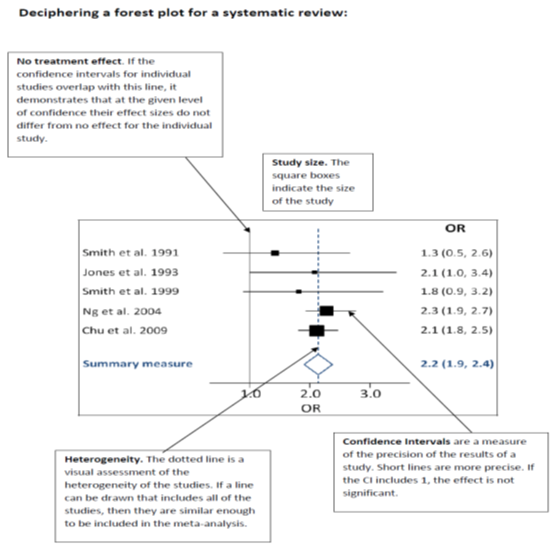Online Course
NRSG 795: BIOSTATISTICS FOR EVIDENCE-BASED PRACTICE
Module 10: Other Common Uses of Statistics and the Need for Good Data
Meta-Analyses
When effect sizes are analyzed across studies to get a more accurate estimate of the effect in the population, this is called a meta-analysis. Meta-Analyses also allow the analyst to determine what factors may influence the variation in effect sizes – for example, sample size, study design, study measures, etc.
Some of the content already covered in the class relates to the calculation of effect sizes and the conduct of Meta-Analyses. You have learned that the higher the correlation between two interval level variables, the stronger the relationship between the two variables. Indeed, a Pearson r coefficient, is an effect size. You also know that confidence intervals represent the estimated variation around a point estimate (e.g., mean, mean difference, odds/risk ratio). In Meta-Analyses, point estimates and confidence intervals are used to illustrate the variation of effect sizes across studies – and to calculate a combined effect.
Forest plots are often used in Meta-Analyses to illustrate the findings. Below is a schematic that illustrate what the various features of a forest plot mean.

In an example using data as seen in the plot below, odds ratios (ORs) from 15 studies that reported the impact of a treatment on mortality are summarized (the exact treatments are unknown). The odds ratios and the 95% confidence interval around the point estimates show that all treatments except 1 (Stawer) had an odds ratio of less than one indicating a less likelihood of mortality. Only 4 of the studies had a significant effect – their confidence intervals do not cross the line where OR=1 (Truark, Adams, Truark2, and Adams2). Recall that OR=1 means that there are no differences in the treatment compared to the placebo. Note also that the confidence intervals for two of the significant studies are narrow, reflecting a larger sample size in those studies (this can also be seen in the in weights column which reflects the sample size). The diamond at the bottom illustrates the combined effect. Since it does not cross the OR=1 line, the combined effect favors the treatment.

Meta-Analyses and systematic reviews can be found through traditional library search strategies. One of the best databases of such reviews is The Cochrane Collaboration, a not for profit international collaboration whose mission is “to promote evidence-informed health decision-making by producing high quality, relevant, accessible systematic reviews and other synthesized evidence.”
Required Readings and Videos
- Introduction to Systematic Review and Meta-Analyses (16:56)
https://www.youtube.com/watch?v=WB9pbHqUs5c - Intro Statistics 10 Meta Analysis (8:12)
https://www.youtube.com/watch?v=u5uN3drVSkE
This shows how an Excel Add-in/macro can be used to develop forest plots illustrating effect sizes and confidence intervals across studies.
Learning Activity
- Practice interpreting results presented in a systematic review paper by answering these questions as they pertain to the figure below

Check your responses here. - Go to the Cochrane Collaboration website – www.cochrane.org. Click on “The Cochrane Library” in the upper right hand corner and search an outcome in your interest area.
Notice the specificity of the relationships examined (e.g., different treatments, different outcomes, etc.). Select one of the reviews, review the abstract, and answer the following questions:
— How old is the review? Might the results be outdated?
— How many studies were included? Do you think there were enough to make recommendations for clinical practice?
— What measure of effect size was compared across the studies?
— Examine the tables and figures. Is there a Forest plot that summarizes the findings? If yes, can you easily see the combined effect size?
- Complete the Module 10 Self-test.
This website is maintained by the University of Maryland School of Nursing (UMSON) Office of Learning Technologies. The UMSON logo and all other contents of this website are the sole property of UMSON and may not be used for any purpose without prior written consent. Links to other websites do not constitute or imply an endorsement of those sites, their content, or their products and services. Please send comments, corrections, and link improvements to nrsonline@umaryland.edu.